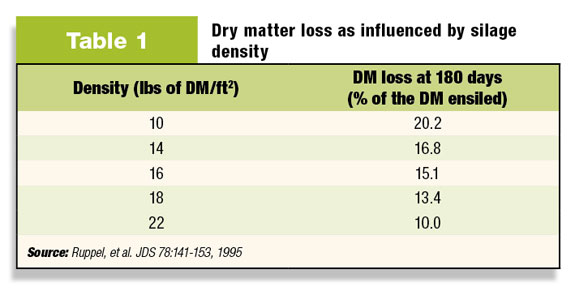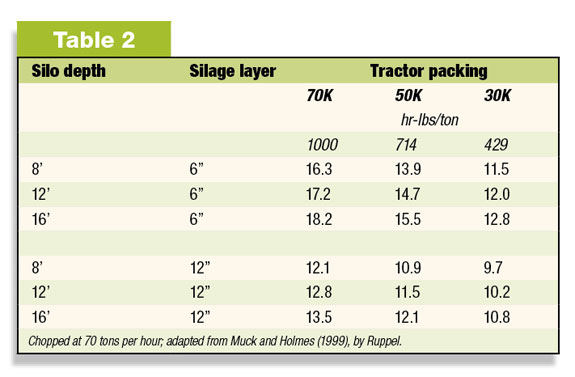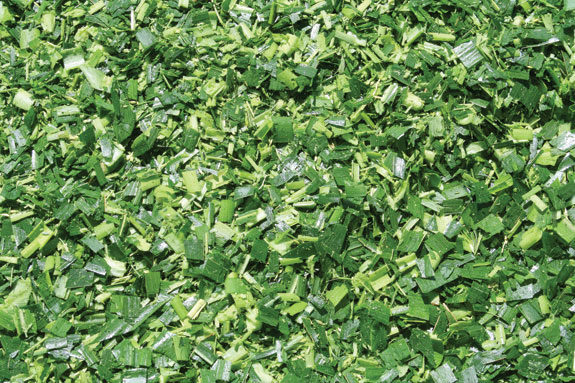It takes time to pack silage correctly, and time is a scarce commodity these days. Understanding both what it takes to pack correctly and the consequences of not doing so is critical to resolving the conflict.
The penalty for loose-packed, low-density corn silage is twofold: shrink and more storage space required.
Shrink
When silage is made, oxygen is the enemy. Freshly chopped corn silage is oozing with crop sugar and other valuable nutrients that aerobic (oxygen-requiring) microbes will rapidly convert into heat, carbon dioxide and water through a process known as respiration.
Removing oxygen from the pile as quickly and effectively as possible allows anaerobic (oxygen-hating) silage bacteria to convert the sugar into silage acids that preserve the remaining nutrients.
Allowing the oxygen to remain until it is used up by respiration results in high shrink, and the value of that shrink is often determined by the tons lost times the value of the silage.
However, the least valuable nutrients are left behind in this process and the most valuable nutrients are the ones that are lost, so the value per ton lost is actually much greater than the value of whole-corn silage.

Table 1 shows the relationship between silage density and dry matter (DM) lost in a study of haylage. As you can see, the difference between 18 pounds of DM density and 13 pounds is nearly 7 percent shrink.
If you have a 5,000-ton pile and value the corn silage at $50 per ton, that 7 percent is worth $17,500. However, if you consider the above and value the lost nutrients at $200 per ton, the loss is more in the neighborhood of $70,000.
Many people don’t consider the sugar in corn silage when thinking about its valuable nutrients. We often see production responses when we can meet a cow’s requirement for a nutrient we call rumen soluble sugar or RSS.
RSS are the sugars that grow specific rumen microbes efficiently and their end products and microbial mass result in higher pounds of milk components, often improving what we call milk component efficiency or the pounds of total milk components (fat plus protein) made divided by the total dry matter intake.
When diets are offered forages with just a 0.5 percent reduced RSS level, the cost of feeding that cow is increased by 15 to 20 cents per cow per day to maintain the same level of production.
If our 5,000-ton pile of silage is being fed at a rate of 15 pounds of DM per cow per day, it will feed 1,000 cows for 233 days. An increase of diet cost of 15 cents per cow per day for that many cows over that period amounts to $35,000.
More storage space required
The capital required to build pads or walls to store silage is a significant investment. The dollars invested per ton of stored silage is increased when proper density is not achieved through packing.
Continuing to use our 5,000 tons of corn silage, if we have an effective height of 20 feet and width of 75 feet, we will need a length of 130 feet if we can pack the silage at 18 pounds of DM density per cubic foot.
However, if we can only achieve a density of 15 pounds DM per cubic foot, we will need a length of 155 feet.
If we can only get 11 pounds of DM density per cubic foot, now the length is up to 201 feet. What’s that, you say?
You will just go higher? Sure, that is what most people do; however, now you are doubling-down on your losses.
Trying to make a pile on top of a pile results in more exposure to air throughout the storage period, and it is more difficult and time-consuming to pack, so now your density may be as low as 6 to 10 pounds of DM per cubic foot.
Any way you calculate it, the dollars at risk for loose packing are significant. How then, do we resolve the conflict?
Resolving the conflict
The process of achieving the silage densities needed to avoid the shrink losses and added capital requirements for silage storage described above are well understood. Silage density is most affected by three distinct factors:
1. the time spent packing and tractor weight in relation to the rate silage is brought into the silage storage area
2. the loose silage layer thickness under the wheels of the tractor
3. the height of the silage pile

In Table 2 these well-understood relationships are calculated out for a silo-filling scenario of 70 tons per hour.
The higher the packing factor, the thinner the loose layer under the wheels and the higher the pile, the greater the silage density achieved.
The number used to describe packing time and weight in relation to silage fill rate is hour-pounds per ton.
If you are using tractors that add up to 70,000 pounds and are filling the silo at a rate of 70 tons per hour, you are achieving packing at 1,000 hour-pounds per ton.
In Table 2 you will see that if you pack at 1,000 hour-pounds per ton, you can achieve very high silage DM density.
A commonly cited figure is to achieve 800 hour-pounds per ton of packing, which is more achievable with today’s filling rates, but still a challenge in many situations.
When we get silo filling rates at 100 to 200 tons per hour it is impossible to put enough tractors on the pile to get anywhere close to 800 hour-pounds per ton.
However, the layer thinness at 6 inches on the higher piles will allow you to get above-average density (15 pounds DM per cubic foot) at 700 hour-pounds of packing.
Figure 1 further illustrates the drastic reduction of weight transferred from tractor wheels to silage as the loose silage beneath the wheels increases.
Tractor coordination
It may take three to five tractors to get to 700 hour-pounds when bringing in trucks of silage at a rate needed to avoid any of the dangers of having the corn out there and exposed.
You must spread each load thinly and rapidly in order to achieve the silage densities needed to avoid serious additional feeding and storage costs.
Our most successful dairy operators are achieving the coordinated flow of multiple tractors needed to get their crops in quickly and achieve the silage density needed to avoid the added costs. FG
References omitted due to space but are available upon request.

Kurt Ruppel
Technology Leader
Cargill Animal Nutrition











